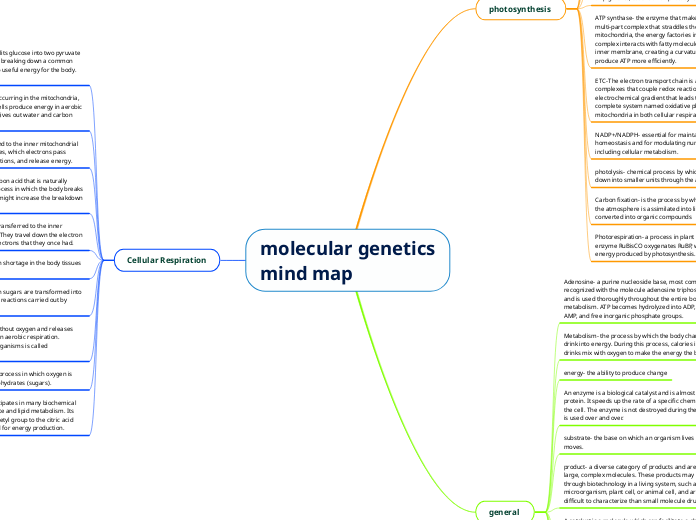
chloroplast- Plant cells and algal cells contain chloroplasts, the organelles in which photosynthesis occurs. All chloroplasts have at least three membrane systems
Thylakoid-pouch-like sacs that are bound to a membrane in the chloroplasts of a plant cell
stroma-Inside the outer and inner membranes is the chloroplast stroma, a gel-like fluid that makes up much of a chloroplast’s volume and in which the thylakoid system floats.
light dependant reaction-During the light-dependent reactions, light energy is captured by pigment molecules. is the pigment that most plants use to complete this job...Once the photon of energy is absorbed, there are three possible outcomes-The electron returns back to ground state The energy of the excited electron is transferred to an electron in a neighbouring pigment molecule.
light independent reaction-after light absorption, they transfer excitation energy to chlorophyll a molecules, then the primary electron acceptor in the reaction centre the complex of proteins and pigments that contains the primary electron acceptors. A pigment molecule does not absorb all wavelengths of light. calvin cycle- Fixation of carbon dioxide:
Reduction of 3-phosphoglycerate to G3P: Each molecule of
Regeneration of RuBP from G3P:
pigments- Carotenoids and chlorophyll are two chromophores, or pigments, essential for photosynthesis.
ATP synthase- the enzyme that makes ATP molecules. It is a multi-part complex that straddles the inner membrane of mitochondria, the energy factories in cells. The enzyme complex interacts with fatty molecules in the mitochondrial inner membrane, creating a curvature that is required to produce ATP more efficiently.
ETC-The electron transport chain is a series of four protein complexes that couple redox reactions, creating an electrochemical gradient that leads to the creation of ATP in a complete system named oxidative phosphorylation. It occurs in mitochondria in both cellular respiration and photosynthesis.
NADP+/NADPH- essential for maintaining cellular redox homeostasis and for modulating numerous biological events, including cellular metabolism.
photolysis- chemical process by which molecules are broken down into smaller units through the absorption of light.
Carbon fixation- is the process by which inorganic carbon from the atmosphere is assimilated into living organisms and converted into organic compounds
Photorespiration- a process in plant metabolism where the enzyme RuBisCO oxygenates RuBP, wasting some of the energy produced by photosynthesis.
Adenosine- a purine nucleoside base, most commonly recognized with the molecule adenosine triphosphate, or ATP, and is used thoroughly throughout the entire body in general metabolism. ATP becomes hydrolyzed into ADP, or further to AMP, and free inorganic phosphate groups.
Metabolism- the process by which the body changes food and drink into energy. During this process, calories in food and drinks mix with oxygen to make the energy the body needs.
energy- the ability to produce change
An enzyme is a biological catalyst and is almost always a protein. It speeds up the rate of a specific chemical reaction in the cell. The enzyme is not destroyed during the reaction and is used over and over.
substrate- the base on which an organism lives or over which it moves.
product- a diverse category of products and are generally large, complex molecules. These products may be produced through biotechnology in a living system, such as a microorganism, plant cell, or animal cell, and are often more difficult to characterize than small molecule drugs.
A catalyst is a molecule which can facilitate a chemical reaction without being consumed or changed. Virtually all chemical reactions taking place in a living cell require catalysts. Such biocatalysts are called enzymes.
Activation energy is defined as the minimum amount of extra energy required by a reacting molecule to get converted into a product.
Chemical reactions occur when chemical bonds between atoms are formed or broken. The substances that go into a chemical reaction are called the reactants, and the substances produced at the end of the reaction are known as the products.
redox reaction-are reactions that involve the transfer of electrons from one species to another. The species that loses electrons is said to be oxidized, while the species that gains electrons is said to be reduced.
Mitochondria- membrane-bound cell organelles
gyclosis- Glycolysis ultimately splits glucose into two pyruvate molecules. Glycolysis is used for breaking down a common carbohydrate called glucose into useful energy for the body. occurs in the cytoplasm
kreb cycle-a chain of reactions occurring in the mitochondria, through which almost all living cells produce energy in aerobic respiration. It uses oxygen and gives out water and carbon dioxide as products.
ETC-a collection of proteins bound to the inner mitochondrial membrane and organic molecules, which electrons pass through in a series of redox reactions, and release energy.
pyruvate-Pyruvate is a three-carbon acid that is naturally formed during glycolysis, the process in which the body breaks down sugar (glucose). Pyruvate might increase the breakdown of fat
FAD/FADH2- electrons and are transferred to the inner membrane of the mitochondria. They travel down the electron transport chain, releasing the electrons that they once had.
oxygen debt-a temporary oxygen shortage in the body tissues arising from exercise
Fermentation- a process in which sugars are transformed into a new product through chemical reactions carried out by microorganisms.
Anaerobic respiration- occurs without oxygen and releases less energy but more quickly than aerobic respiration. Anaerobic respiration in microorganisms is called fermentation.
Aerobic respiration- A chemical process in which oxygen is used to make energy from carbohydrates (sugars).
Acetyl-CoA- molecule that participates in many biochemical reactions in protein, carbohydrate and lipid metabolism. Its main function is to deliver the acetyl group to the citric acid cycle (Krebs cycle) to be oxidized for energy production.